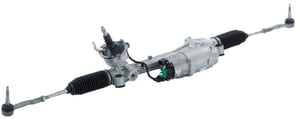One of the big challenges when designing and manufacturing auto parts is ensuring that they operate reliably in very hot environments, such as Dubai, where the high temperature can easily reach 40˚C. Of course, they must also operate reliably in very cold environments, such as Siberia, where the thermometer can drop to -40˚C or below. You certainly don't want parts to fail when you're zipping down the road at 200 km/hr. because they can't take the heat (or the cold).
To ensure that their products don't fail, most supplier will perform some kind of environmental testing. They will place the parts in an environmental test chamber and simulate the environment in which the component must operate. A computer is used to put the component through its paces while in the chamber.
The manufacturer of the electrically-powered, steering belt drive shown above designed just such a test. This drive features a modular design and can be used in vehicles as small as C-segment vehicles and as large as full size trucks. It can handle rack loads as high as 18kN and features a fully integrated steering gear that can be mounted in either inboard or outboard configurations.
The test system for this drive included:
- An environmental test chamber capable of producing ambient temperatures as high as 85˚C and as low -40˚C. The chamber also has humidity control that enables it so simulate a wide range of operating environments.
- A 19-in. rack to house the test system instrumentation.
- A rack-mounted Sorensen SGA 20x500D DC power supply, with a GPIB interface, to supply power to the device under test (DUT).
- Rack-mounted instrumentation required to monitor the output of the electrically-powered, steering belt drive's sensors.
- A rack-mounted computer running a test program to control the environmental chamber and the Sorensen SGA power supply. The computer simulates the drive's ECU (Electronic Unit Control), sending commands to the drive's actuators and measuring the drive's sensor outputs. In addition to running the test, the computer outputs a test report once a test run is complete.
While a number of different temperature profiles is available with this system, a typical profile would look like the following:
- 23˚C for 30 minutes.
- -40˚C for six hours
- 85˚C for 70 hours
At these temperatures, the computer will run a series of performance tests to ensure that the drive will operate reliably at these temperatures. During the course of these tests, the DUT power supply voltage can also be varied to test the drive's sensitivity to input power variations.
In most automotive applications, it is not necessary to use a DC power supply with fast rise and fall times, but a programmable power supply is a must to test input voltage sensitivity. The Sorensen SG Series is a good choice because they have a wide range of voltage and current capabilities which allow you to choose the model that's right for your application. They also have very stable outputs, which is important because tests can last a long time.
For more information on how you can use Sorensen DC power supplies and other AMETEK Programmable Power products in automotive applications, contact AMETEK Programmable Power. You can send an e-mail to sales.ppd@ametek.com or phone 800-733-5427.




